The Business of Infrared Home Inspections
Sponsored by:
Bart Bruni
Level 1 Thermographer #6455
Bestec Home Inspections
323 SE First Avenue
Hallandale Beach, FL 33009
PH: 954-458-1104 / FAX: 954-458-0607
Abstract
Incorporating infrared inspections with traditional home inspections can be a new source of revenue for the traditional home inspector. This paper will discuss which areas of the marketplace are best suited for infrared home inspection and how to create recurring income from this type of inspection. It will also cover what to look for and be aware of during an infrared survey as well as best practices to reduce your liability when producing your infrared home inspection report.
Introduction
Buying or selling a home is a major life event for most people. It seems reasonable that buyers would want an objective opinion from someone who has experience in home inspections. Is experience enough? What is enough experience? What is required to be a “State Certified Home Inspector”? Those requirements change from state to state.
In Florida there is no certification necessary, a business license is all you need. There are organizations such as The American Society of Home Inspectors (ASHI) where one can seek some credibility.
Two conclusions are easily drawn from these results.
First, however, one must realize that there are neither international nor US standards for temperature calibration of these devices. The survey showed what this situation can produce.
Discussion
Most people who are buying a home have a few reasons to purchase a home inspection. First “it is a good idea”. They also need a budgetary estimate on the damage that is reported. The budgetary estimate is necessary to buyers who plan to finance conventionally. The Limited Repair Clause that was written in most listing agreements allows the seller to control the cost of repairs if any are found after an offer has been made and deposit has been given on their property. It is usually two or three percent of the property value. The buyer sees this clause as “find the damage now or forever hold our peace”.
The information received from the home inspector’s report is often necessary to exercise the limited repair clause. In a perfect world the report would read “this is a great house, there is nothing to report”. In most cases, repair clause monies are deducted from the total price of the property at closing.
Infrared Home Inspections are becoming a must to high-end home buyers and investors. A weak stock market and low interest rates have created many newcomers to the real-estate marketplace.
We have found that the high-end client’s needs are greater than the average home buyer due to larger properties and higher demand for additional information.
Insurance companies have a need for inspectors to help adjust their claims. Public claims adjustors have a need for an outside opinion. They want the peace of mind of knowing that whatever the final buying decision is, valuable information was shared that justified one’s action to buy or not to buy. Home inspections should supply all these needs, and infrared home inspections assure the buyer that if there is damage to find, this technology and your expertise will find it.
Here are some basic areas to inspect during a standard home inspection using nothing more than a flashlight, ladder and perhaps a moisture meter.
General:
-
Any major changes to the property?
-
Agreed upon modifications or repairs completed?
-
Receipts / warranties / guarantees provided by repair contractors?
-
Pest control clearance provided?
Roofing:
-
Indications of roof leakage?
-
Gutters and downspouts secure?
-
Signs of roof surface, flashings, vent or chimney damage?
-
Was the roof walked on?
Exterior:
-
New cracks, paint peeling or other visible defects?
-
Trip hazards, cracking in the walkways, driveway, or steps?
-
Plants growing on the building?
-
Stairways, decks, porches and other railings secure and proper?
-
New cracks or indications of retaining wall failure?
-
Signs of inadequate surface drainage?
-
Openings into the building at trim, flashings, chimneys, etc.?
-
Do the windows appear to be in good condition from the outside?
-
Is the driveway in good condition?
Subfloor Area / Basement:
-
Accessible areas dry?
-
Indications of new water entry?
-
Sump pump operational?
-
Indications of new foundation cracking or movement?
-
Musty odors or signs of mold or mildew?
Interior:
-
Stains, cracks or damage to interior walls, ceilings or floors?
-
Cracked or broken windows?
-
Windows and window latches operate properly?
-
Doors and door latches operate properly?
-
Interior staircases have safe, secure handrails?
-
Smoke alarms in hallways, on each floor, in each bedroom?
Kitchen & Bathrooms:
-
Are the stove, microwave, and dishwasher operational?
-
Cabinets, countertops, sinks or floors damaged?
-
Is the range ventilation operational?
-
Is the garbage disposal operational?
Electrical:
-
Light fixtures operate?
-
Outlets functional?
-
Smoke detectors provided and functional?
-
Doorbell operational?
-
GFCI outlets in kitchen, bathrooms, exterior and garage?
-
GFCI devices functional?
-
Dangling or exposed wiring?
-
Extension, lamp cord, or zip cord used as permanent wiring?
Garage:
-
Vehicle doors functional?
-
Fire-rated doors provided?
-
Automatic door openers reverse properly?
-
Fire-rated surfaces at house walls, attic and subfloor areas?
-
Indications of dampness or mildew?
Heating / Cooling:
-
System functional?
-
Serviced recently?
-
Adequate heat / cooling distribution to rooms?
Fireplace:
-
Safety check on older fireplaces and chimneys?
-
Dampers operational?
-
Fire boxes need repair?
-
Spark arrestor and rain cap installed?
Example of damage and Limited Repair Clause: The following photos are of a home that was sold for $750,000. There was a 3% damage repair clause that equaled $22,500. We will look at how infrared adds to this home inspection and helps to meet the end user’s expectations as well as their needs. Without infrared proof, the repair estimate would have been significantly less money.
These are some photos typical to a traditional home inspection part of the report.
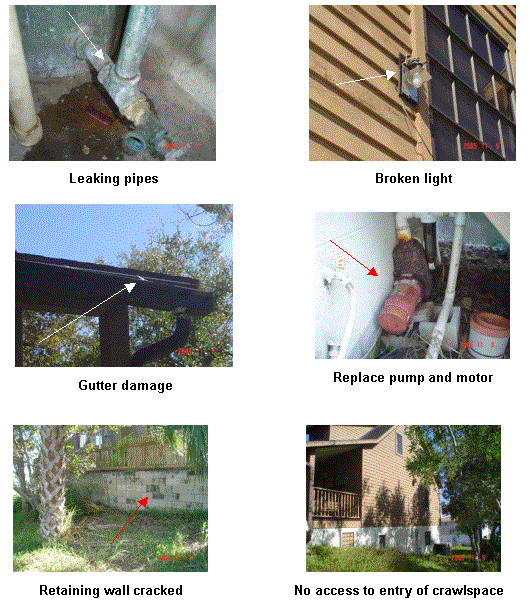

A termite inspection and roof report was also required by this client. Most home inspectors outsource this task to a licensed pest company and licensed roofing company.
With infrared home inspections, we can combine the termite report, roof report, and enhanced home inspection report. This repot is supplemented with photos, as seen above. This service is valued at about $250 to $300 for an average sized home.
You can add to, refine, and customize your checklist and report, but remember your client’s needs: beware of over reporting or reporting on items that can be easily checked by the end user.
Stand alone Infrared Home Inspections without any other issues to report on except moisture, energy conservation, and pests, can be of great value to the end user. The way we perform this type of inspection is room by room, documenting ceilings, walls, and floors. The scope of the inspection consists of: Moisture Survey, Energy Survey, Leak Detection, Fungi and Wood Destroying Organisms.
A visual inspection of the attic, crawlspace, exterior of the home and foundation are also performed. This part of the inspection is so that if we discover major repair issues or safety concerns we can report them; however, I do not render a structural opinion on a home.
If we couple the traditional Home Inspection with the Infrared Home Inspection, a new product emerges that meets the needs of the end user. The average price changes from $250 to $300 for a visual home inspection to $750 to $2,500, thus a creating a new market for the high-end home buyer. This is a market where the prospective clients are desperately awaiting these services.

In this home, there was a false chimney enclosing the exhaust system for a wood burning stove. As you can see, there is a thermal difference.

Inspecting further we found that the wood siding read 20% plus. The end result was that a “walk on roof inspection” was necessary and showed the top exhaust stack was not closed properly and thus water was leaking in.
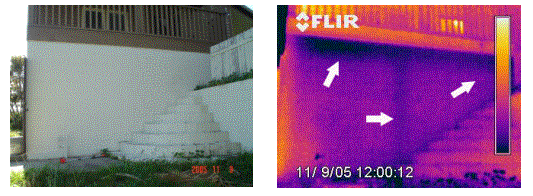
The basement wall has a moisture problem, which brought damage repair dollars to the buyer.
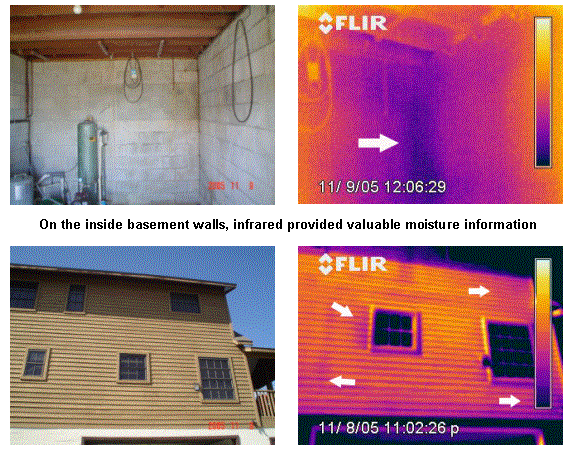
Moisture meter readings were over 20% in some of the wood siding where the arrows are pointing. The buyer used this information to finalize his offer to buy this home. This client spent $1,500 on an IR Home Inspection and Termite Inspection and received tens of thousands from the seller for repairs.
Combining the practices of the traditional home inspection and an infrared home inspection produces a better service to the end user.
Let’s look at some stand-alone infrared home inspection images taken after hurricane Wilma for insurance purposes.
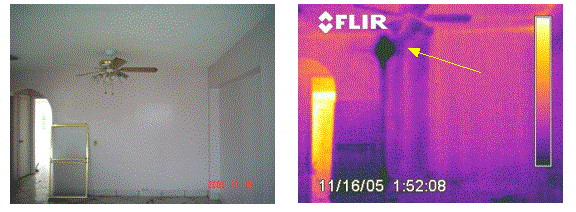
This home received major water damage during Wilma; however, the client and the insurance company wanted to know where the water was coming from. When I arrived, there was standing water in the house. A roof inspection had been performed and no breech in the roof system was reported.
The wall that had shown this anomaly is common to the A/C handler closet of which is leaking above the ceiling line.
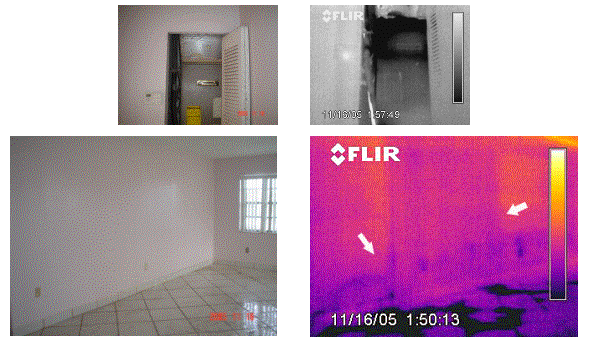
Standing water on the floor wicked up the wall. This was over 20% wet anywhere we touched it with our moisture meter. This was consistent to all the walls in this home.
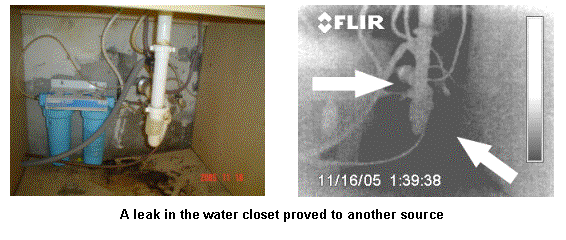
Here are other IR home inspection images that show typical moisture damage after a hurricane.

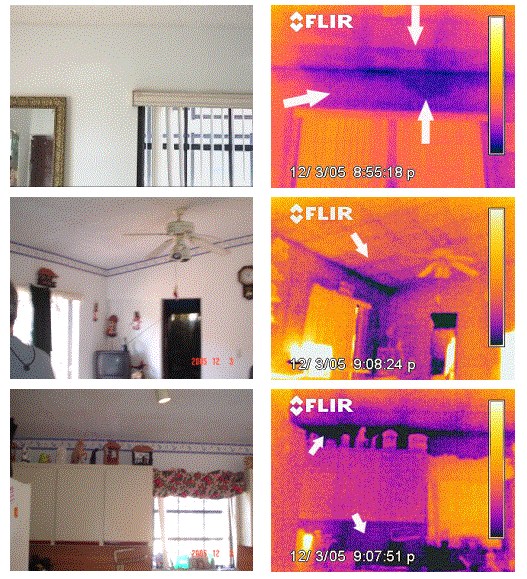
Newly constructed homes and buildings have a need for IR inspections. IR home inspections provide baseline moisture and temperature documentation. Here are some IR baseline inspection images of a recently built municipal building.
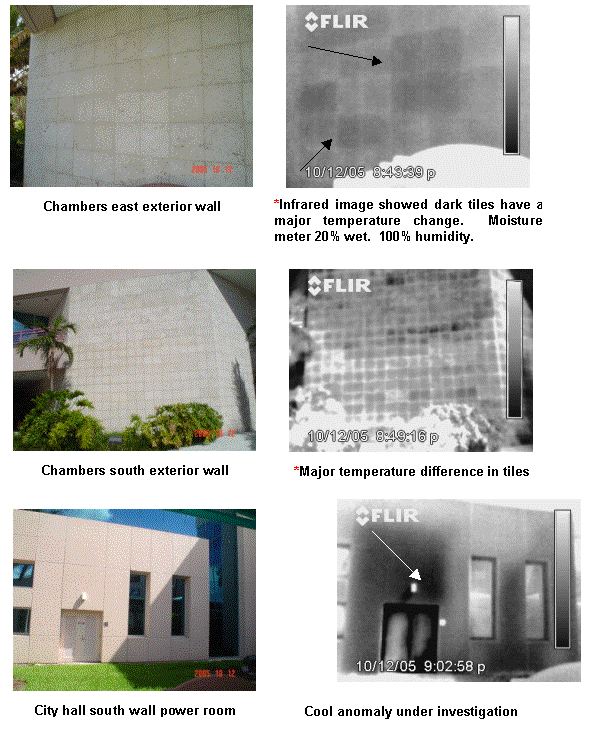
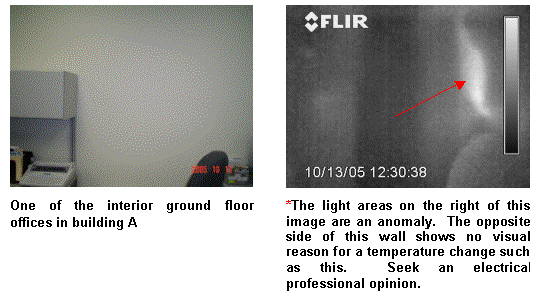
I will use the images from this inspection as a building baseline inspection. When necessary, future images can be compared. Many developers and new home contractors have a need for IR moisture inspections. They like to know that the home they have contracted to be built is not harboring issues that may haunt them at a later date. When pre-construction home buyers visit the site during the construction phase after a rain, it brings up the question, “How does that affect our new home?”. That leads to what is commonly called mold or black mold, blue mold, toxic mold, etc. Pre-owned homes located close to the equator have the proper conditions for fungi growth and need to be inspected periodically for areas that are consistently 25% moist with a minimum 80% humidity. Truth be known, last year in the US there were no reported deaths from “mold”; however, 38,000 people did die of the flu last year. That is not to say that the affects of over exposure to fungal spores is not healthy and can cause death.

Attics are important areas to visually inspect. Always exercise safety when performing attic inspections. Some issues you may want to address are protective wear such as eye protection, crawl-suit, hardhat, dust mask, etc. Make the first area of your inspection the electrical wires. Check the soundness of the wood as you go by, hitting the truss in various areas with a hammer or screwdriver.
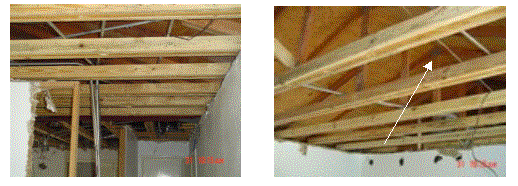
Termites had eaten this attic to the point of structural failure. The rafter beams had to be scabbed together with good wood.

A girder was installed to save this roof. This IR image is what it looked like after all repairs were made. If you see this during an IR home inspection, report it. Those images were of a home that had been badly damaged due to a poor inspection program; this home was under the coverage of a major termite company. Apparently, attic inspections were not a part of their protocol. There was a lawsuit and the homeowner received a large cash settlement.
Liability is a factor that must be managed. Here are some ways to reduce the risks. The obvious is watching what we say and write. Maintain quality in all your home inspections. Establish standards and stick to them. Use accurate language when speaking or writing about your inspections. An example is the word “mold”. This word can get your company into a high risk situation. A better way to describe this natural process is “Surface Fungi”.

Some other things I would like to share with you about reporting on home inspections. A good portion of your report should be areas where you have abnormalities and a portion describing areas that you did not inspect. In home inspection reporting, where you did not inspect is as important as where you did. Avoid tricky words like “water damage” or “wet”. I suggest using verbiage such as “temperature differentials” or “moisture meter reading was at the time of the inspection”. The best tip I can give about the infrared home inspection business is to prepare good pre-inspection and inspection agreements, then have them looked at closely by your attorney and your insurance provider.
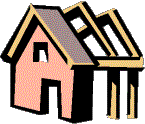
Conclusion
The best way to have recurring income in the home inspection industry is any way that you can get it. It is that important of a factor as it relates to your business growth and net worth. Some of the ways that I have provided recurring income in my IR home inspection division have been developing the right contacts; I woo brokers as opposed to realtors; I build relationships with developers as opposed to contractors. I stay in touch with my clients; I bundle IR home inspection services together with other targets such as roof and pest inspections that need annual service. Then, I perform an IR moisture inspection and preset the yearly renewal fee in the initial inspection agreement. You can pick up 20% or 25% of the initial inspection cost each year.
The commercial marketplace is another good area to find recurring income due to the fact that commercial building owners are into preventive maintenance programs, and this could mean scheduling inspections a year or two in advance at a predetermined fee.
For more ways, use your imagination, be creative, keep the end user’s best interests in mind and make money.
Attached is a home inspection checklist for you to use while doing a standard home inspection.
I sincerely wish you well in this area of thermography!
Advertisement


